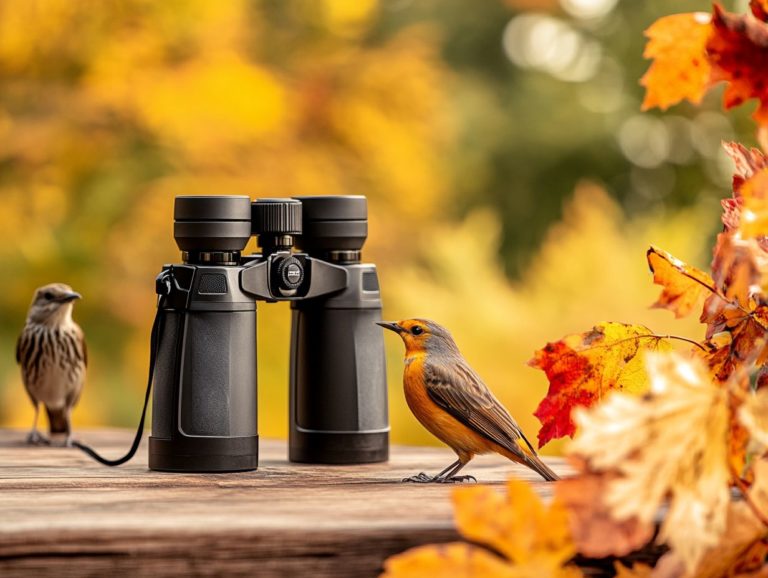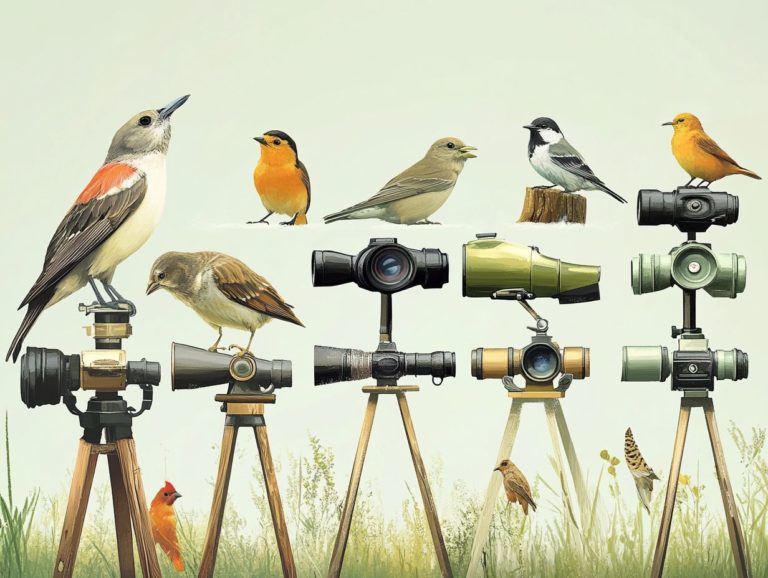The Benefits of Image Stabilization in Binoculars
If you use binoculars, image stabilization is a game-changer! It turns shaky views into clear images, letting you savor every moment.
Whether you re birdwatching, stargazing, or soaking in breathtaking landscapes, image stabilization can significantly enhance your experience.
This article explores the types of image stabilization in binoculars. You’ll learn their benefits and practical tips for choosing and using them effectively.
Get ready to elevate your outdoor observations to new heights!
Contents
- Key Takeaways:
- Advantages of Image Stabilization
- Discover the Best Image Stabilization Types for Your Adventures!
- Factors to Consider When Choosing Image Stabilization
- Tips for Using Image Stabilization in Binoculars
- Frequently Asked Questions
- What is image stabilization in binoculars?
- What are the benefits of image stabilization in binoculars?
- Are there different types of image stabilization in binoculars?
- What are some situations where image stabilization in binoculars would be beneficial for activities like birdwatching and marine activities?
- Do all binoculars have image stabilization?
- Are there any downsides to using image stabilization in binoculars, like those made by Leica or Zeiss?
Key Takeaways:

- Image stabilization makes your views crystal clear. You can enjoy birdwatching or stargazing longer without tiring your eyes.
- Using binoculars with image stabilization helps reduce fatigue, perfect for long outdoor adventures.
- When choosing image stabilization in binoculars, consider your budget and intended use, as well as features like waterproofing or magnification power.
What is Image Stabilization?
Image Stabilization (IS) helps binocular users see clearly by reducing blurriness from hand movements. This technology uses sensors to detect motion and adjust the image, delivering shake-free visuals.
Whether you’re birdwatching, stargazing, or enjoying marine activities, the advantages of image stabilization can elevate your satisfaction.
By minimizing the impact of hand tremors and disturbances, IS transforms your interaction with optical devices. For example, it allows you to catch fine details while birdwatching without the annoying shake that traditional binoculars often have.
If you’re an astronomer, this amazing technology supercharges your observation skills, making it easier to spot distant celestial bodies where every fleeting glimpse of the night sky matters.
With the support of gyroscopic sensors, these experiences become not only clearer but also more immersive, allowing you to truly appreciate the marvels of nature and the cosmos without compromise.
Advantages of Image Stabilization
The benefits of image stabilization in binoculars are impressive, especially for high-magnification activities like birdwatching or stargazing. IS binoculars boost your viewing experience by keeping images clear, even when observing distant subjects.
Options like Canon IS binoculars and Kite Optics APC are designed with these advantages in mind. They offer lightweight designs that allow for extended use without discomfort.
Improved Image Quality
One of the primary benefits of image stabilization is the remarkable improvement it brings to optical quality. IS transforms shaky visuals into crystal-clear images that truly enhance your viewing experience.
When you engage in activities where precision is paramount, such as wildlife observation or stargazing, you’ll appreciate this technology. The advancements in image stabilization minimize vibrations and often include features like ED lenses, significantly reducing chromatic aberrations and enhancing color fidelity.
This clarity is critical when tracking a hawk’s flight or gazing at distant celestial bodies where even the smallest detail can have a profound impact. Ensuring these experiences are accompanied by shake-free images elevates your enjoyment and satisfaction.
Experience the thrill of tracking a hawk s flight or gazing at distant stars without the shake! Enjoy the wonders around you like never before.
Easier to Use for Extended Periods

Using binoculars with image stabilization technology elevates your experience remarkably. They are easier to handle during long birdwatching or marine excursions.
The lightweight design of many models allows you to hold them comfortably for hours. This significantly enhances your enjoyment, especially if you spend extended periods observing wildlife or stargazing.
In such pursuits, the magic is often found in the small details. These are fleeting moments that might slip by unnoticed without the right gear. With these binoculars, you can truly immerse yourself in your surroundings, capturing that rare glimpse of an elusive bird or the delicate movements of marine life beneath the waves.
This blend of comfort and user-friendly features enhances your enjoyment. You ll be encouraged to use them more often and for longer stretches.
Ultimately, the right pair of binoculars can transform an ordinary day into an extraordinary adventure. This allows you to cultivate a deeper appreciation for nature’s wonders.
Discover the Best Image Stabilization Types for Your Adventures!
When you think about the types of image stabilization in binoculars, two prominent methods come to mind: mechanical stabilization and electronic stabilization.
Mechanical stabilization uses small spinning devices to counteract motion. In contrast, electronic stabilization uses tiny computers to improve your view digitally.
Renowned brands like Canon IS and Nikon have crafted distinct versions of these technologies, tailoring their offerings to meet diverse user needs and preferences. This can significantly influence your choice of binoculars for pursuits like stargazing and birdwatching.
Mechanical vs. Electronic Stabilization
Mechanical stabilization and electronic stabilization offer two distinct pathways for enhancing optical quality in binoculars. Each has its own set of advantages and drawbacks.
Mechanical stabilization employs physical mechanisms to counteract movement. Meanwhile, electronic stabilization leverages advanced technology to achieve similar outcomes in a digital manner.
You can select between these methods based on your specific needs. Whether you’re engaging in dynamics marine activities or enjoying the tranquility of birdwatching, each method has its strengths.
If you need a stable view while observing wildlife from a moving boat, electronic stabilization can deliver smoother visuals by compensating for vibrations and movements in real time.
Conversely, mechanical stabilization often shines in situations where simplicity and reliability are paramount. This is especially true in high-altitude trekking, where electronic components might be more susceptible to environmental challenges.
Ultimately, the effectiveness of each method aligns with your preferences for durability and ease of use. This significantly influences your choice of binoculars tailored to your unique outdoor adventures.
Factors to Consider When Choosing Image Stabilization
When selecting binoculars with image stabilization, several factors deserve your careful consideration. These include your budget and intended use, as well as compatibility with other features.
Price comparison plays a pivotal role in your purchasing decisions, especially as you strive to balance functionality with affordability.
By understanding how different models align with your specific needs whether for birdwatching, stargazing, or marine activities you can make an informed choice that maximizes both performance and value.
Budget and Intended Use

When setting your budget for binoculars, align it with how you plan to use them, whether for marine activities or birdwatching. Understanding how different price points relate to features helps you make the best purchasing choice.
For whale watching, prioritize models known for low-light performance and waterproof designs. These features allow you to spot distant movements in challenging conditions.
If you’re a casual birdwatcher, you’ll find good options in a lower price range, focusing on portability and ease of use.
The materials used also impact cost. Higher-quality glass and sturdy designs often require a bigger investment. Balancing these factors against your budget enhances your overall binocular experience.
Compatibility with Other Features
Consider how image stabilization works with other features to maximize your binoculars’ effectiveness. Waterproof ratings and light transmission can significantly improve your experience.
Lightweight binoculars with built-in stabilization technology enhance comfort during extended use.
When you choose binoculars with a high waterproof rating, you gain confidence during unexpected rain. This makes every adventure enjoyable and stress-free.
Understanding the synergy between waterproof features and durability helps in activities like hiking. It ensures you get the best usability from your binoculars.
Tips for Using Image Stabilization in Binoculars
To fully enjoy image stabilization in your binoculars, use the right techniques and keep them well-maintained. This commitment elevates your experience.
Holding your binoculars correctly is crucial for clear images, especially during long observation sessions.
Regular maintenance, like cleaning the lenses and checking the stabilization features, is key for optimal performance and longevity.
Proper Technique and Maintenance
Using the right techniques with image-stabilized binoculars enhances image quality. A firm grip while stabilizing leads to clearer, shake-free visuals.
Regular maintenance matters. Routinely clean the lenses and check the stabilization system to ensure optimal function.
For added comfort during long observations, consider a comfortable neck strap. Well-balanced binoculars reduce vibrations and improve your viewing experience.
Neglecting upkeep can lead to dust buildup and misalignment, which compromise image quality. A few moments spent on routine checks can make binocular care effortless, making your outdoor excursions even more enjoyable.
To understand stabilization technology in binoculars better, check out our related videos.
Frequently Asked Questions

What is image stabilization in binoculars?
Image stabilization helps reduce shakiness or blurriness. This technology compensates for hand movements and vibrations, resulting in a clearer and more stable image.
What are the benefits of image stabilization in binoculars?
Imagine a viewing experience where you can enjoy nature without eye strain. Image stabilization provides clearer and sharper images, making it easier to spot and identify objects in your field of view.
Are there different types of image stabilization in binoculars?
Yes, there are two main types of image stabilization in binoculars: optical and electronic. Optical stabilization uses lenses to manage movement, while electronic stabilization uses technology to correct images.
What are some situations where image stabilization in binoculars would be beneficial for activities like birdwatching and marine activities?
Image stabilization is invaluable in various situations, such as birdwatching, marine activities, sports events, and even stargazing. It allows you to maintain a steady view of your subject, even if you’re on the move or in a shaky environment.
Do all binoculars have image stabilization?
No, not all binoculars come equipped with image stabilization. This feature is typically found in higher-end or specialized models. However, some manufacturers offer the option to add image stabilization as an extra feature.
Are there any downsides to using image stabilization in binoculars, like those made by Leica or Zeiss?
One potential downside of image stabilization is the added cost. Binoculars with this feature tend to be more expensive than those without. Additionally, electronic stabilization can drain batteries faster, and optical stabilization may add weight and bulk to the binoculars.
Don’t let shaky views ruin your adventure! Experience crystal-clear observations with image stabilization.






